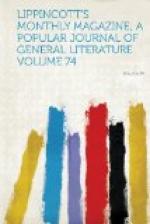The next room is that of the medals and coins, the number of which will probably surprise the visitor not a little. The gold coins and the better-preserved and more interesting specimens are shown single under cleverly-arranged glass cases. The more ordinary results of the finds which are almost daily being made have been consigned in promiscuous heaps to huge glass vases, whose tops, however, are carefully sealed down. The large collections of the aes rude signatum of the consular and of the imperial families, in bronze, in silver and in gold, together with some mediaeval specimens, are ranged around the walls.
Then we come to the sculpture, the main scope of the new museum, which is distributed in a large vestibule, in a noble octagonal central hall and in a long gallery. It was an excellent idea, adding much to the interest which every stranger in Rome will take in the museum, to place on each specimen a placard specifying the locality in which it was discovered and the date of the finding. And this information is admirably supplemented by a map hung against the wall showing in detail the relative positions of all the places which have yielded up these long-buried treasures. The number of specimens of sculpture is in all one hundred and thirty-three; and it is impossible, without letting this notice run to an immoderate length, to attempt to give an adequate account of the various objects, or even of the principal among them. There is a richly-ornamented and very characteristic head of Commodus, which really looks as if it might have come from the sculptor’s hands yesterday. A colossal bust of Maecenas, also the gift of Signor Castellani, a bust of Tiberius, a small statue of the child Hercules, a Venus Anadyomene, may be, and many others might be, mentioned. The last-named is a very lovely statue of a young girl entirely nude. The archaeologists have chosen to call it a Venus, but it is to my thinking clear that it never was intended for the laughter-loving goddess. The expression of the face is perfectly and beautifully chaste, and indeed a little sad. I should say that it must have been a nymph coming from the bath, and just about to clothe herself with the drapery thrown over a broken column at her knee as soon as she shall have completed the arrangement of her tresses, with which her hands are (or, alas! were, for the arms are wanting) engaged.




